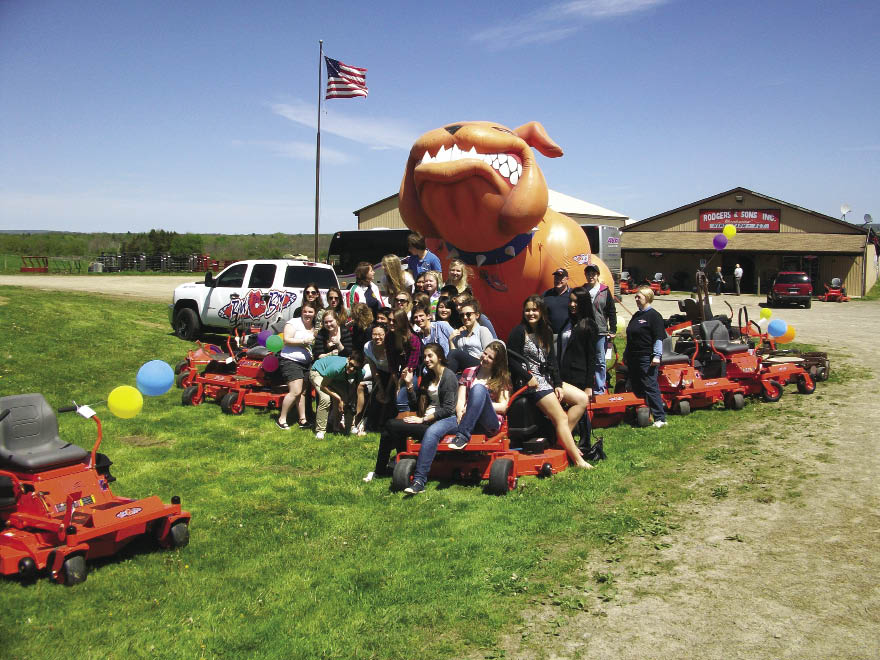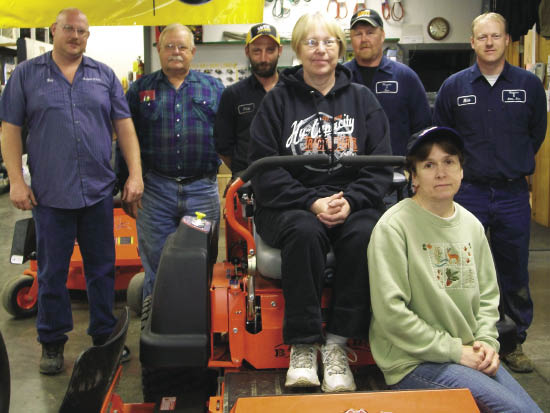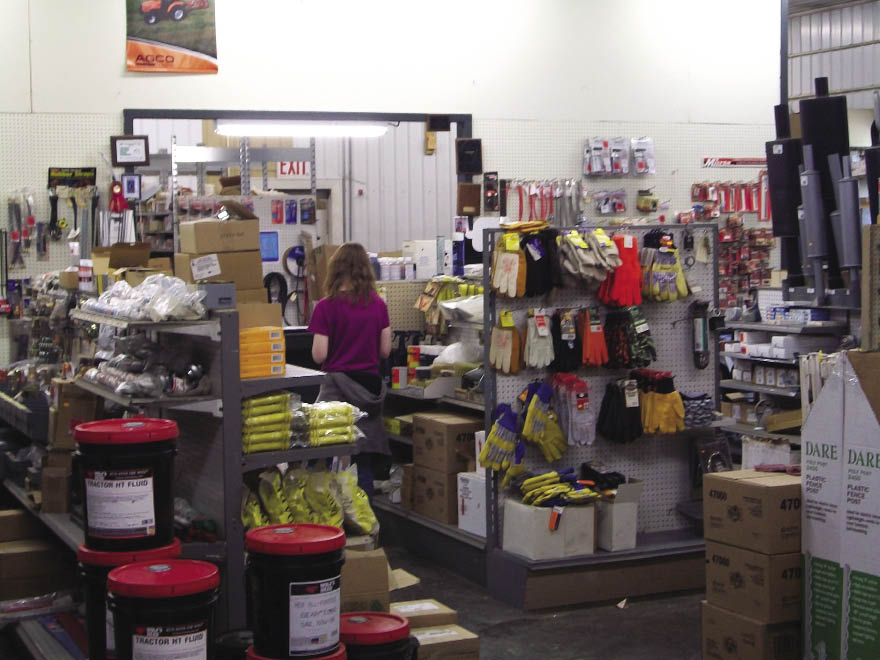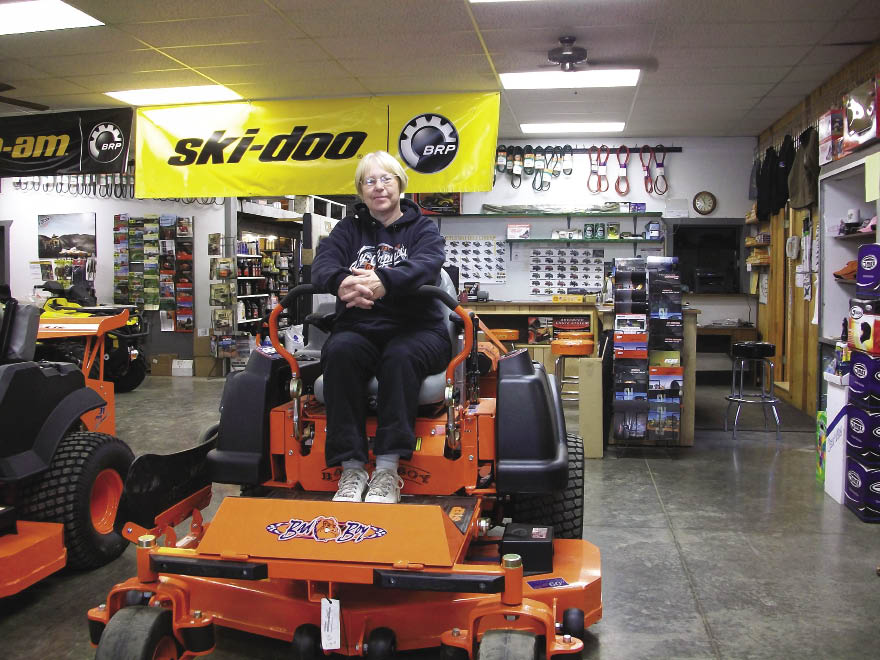Clyde Rodgers, founder and co-owner of Rodgers and Sons, says his Cherry Creek, N.Y., dealership had to adapt to survive during its 25-year history. Some adaptations were by choice; some not. However, they’ve always worked to stay true to who they are: a small, family dealership that is committed to service.
Rodgers and Sons
Location: Cherry Creek, N.Y.
Founded: 1984
Employees: 8
Major line: Kioti and Zetor
Shortlines: Bush Hog, Krone, H&S Manufacturing, Alo, Stoll, Land Pride, Grasshopper, Bad Boy, Echo, Can-Am and Ski-Doo
2011 Sales: $2 million
“Our main business is service,” says Clyde.
Family is what makes that service motto work.
“We have seven full-time employees and one part-time — and five of those are family,” he says.
Clyde’s wife, Jan, is co-owner and parts specialist.
“When we started, my wife didn’t know where to find the index in the parts book. Today, she’s the best parts person in western New York,” he says.
Clyde shows equal pride for his three sons. Bob handles sales and marketing. Mike and Ken handle the service department.
Although Clyde is proud of his sons, he admits he’s sometimes “goes kicking and screaming” when they bring in new ideas, such as transitioning from a strictly ag dealership to serving the rural lifestyle market.
“Everybody that runs a business knows they can do it better than anyone else out there,” Clyde says. “I have to make myself step back and say, ‘These boys went to college and they might have some ideas.’ ”
One of those ideas led to a new direction for this small dealership that’s just fine with being small.

A family is always ready for visitors — and a family-owned dealership is, too. This spring during its open house, Rodgers and Sons welcomed a visit from 26 Rotary Club foreign exchange students from 26 different countries.
The Changing Landscape
Rodgers and Sons is located outside Cherry Creek, about 50 miles from Buffalo, N.Y., and near Lake Erie. Cherry Creek’s population is about 500.
“Cherry Creek is a mile from nowhere, but there’s lots of competition. There are nine ag dealers in the county and it’s only 40 miles across. Most have been here a long time,” Clyde says.
The area is traditionally dairy farm country. That’s how Clyde got his start as a dealer back in 1977. He had been selling David Brown tractors, a British-based model that was later bought by then J.I. Case.
He had an opportunity to enter a partnership with an area dealer. They sold Case IH and New Holland machinery and dairy equipment, such as haybines, choppers and balers.
Modest Beginnings
“We had a junk pickup truck and a toolbox. That’s all we owned,” he says. “At that time, our area was 90% small dairies, one- and two-family operations that had 40-90 cows.”
“Times were good and times were easy. If we sold half of our equipment, manufacturers would carry the other half for another year. That’s unheard of today,” Clyde says.
The partnership lasted until 1984 when he set up his own shop.
“We built a little building next to our house and started into business ourselves. Our neighbors helped build the building. They wanted to see us be there,” he says. “We built a 40 foot x 60 foot building. It had no doors. We just pulled down a tarp at night. We live in a good neighborhood,” he jokes.
The dealership was a family affair from the start. It was named Rodgers and Sons, even though the oldest son, Ken, now 40, was just 14 years old. He remembers sons Bob, 37, and Mike, 38, playing in cardboard boxes when they were young boys.
The dealership’s customers were 100% ag — with 95% of that for dairy. Their main tractor line was Zetor. Most models sold then were in the 50-120 horsepower range
Jan’s View of the Equipment Business
Being a dealership wife is like being a farm wife. You jump in, help out, and support the business any way you can. Jan Rodgers has done just that since she and her husband, Clyde, opened up their dealership in 1984 — and she became the parts person for Rodgers and Sons. She was the first woman to handle the parts desk in Western New York.
“Most of what I learned was at the dealership. A farmer would come in, we’d go to the parts book, and I’d say ‘Show me what you want,’ ” Jan says. Did the farmers mind?
“We have a really good bunch. They were willing to help and they needed the part,” she says.
Jan fills in wherever else she is needed, from bookkeeping to making hydraulic hoses. She’s adapted to her roles, just like the dealership has in its transition into serving the rural lifestyle market.
“It was one of those inevitable things if we were going to stay in business. Farmers just kept getting bigger and doing things over the Internet or with bigger dealers,” she says.
The rural lifestyle and recreational market fit the way they like to do business.
“We’ve always been a small business and a family business and we push service. We’re going to do the best we can as fast as we can,” she says.
She’s also proud to be a resource for farmers and rural lifestylers with older equipment.
“We found over the years that big dealers don’t want to mess with old equipment. They don’t try to find parts.” Jan has developed a resource list of those who carry old parts and she’s kept all her old parts books.
“We try to keep everybody happy. We’ll fix anything — old or new — it doesn’t make any difference,” she says.
“Zetor is a good tractor, a simple tractor. It had the quality and the right price,” says Bob Rodgers of his dad’s decision to offer the line. “We don’t like dealing with the big majors.”
They began selling Kioti tractors in the late 1980s. They were among the first in the area to offer the line, long before compact tractors became the choice of rural lifestylers. They also sold equipment from H&S Manufacturing Co., such as manure spreaders and forage boxes.
“The dairy industry was still decent. It was just the beginning of when larger dairies started coming into the area,” Clyde says. “I remember our best year we sold 18 forage boxes. Now, we sell one or two a year because the big harvesting companies have come in and taken over.”
Changes Coming
The 1990s brought about changes for the dealership on several levels.
“We could see people moving out from the urban areas. There are even some people from Pittsburgh who have cabins near here,” Clyde says, indicating the early stages of the area’s rural lifestyle market.
The ag market was also changing. Large equipment manufacturers were purchasing smaller ones, and Clyde says the emphasis over the next 10 years or so was on larger farms and larger dealerships to support them.
Rodgers looked for new ways to maintain its foothold in the ag market. For instance, in the mid-1990s, they began offering hardware supplies.
“We figured it was a fit for the dairy market. A farmer could come in for a tractor part and for plumbing supplies,” says Bob. It was a way to grow without having to take on more capital expense for larger equipment. They also introduced new products. They were the first in the area to offer bale wrapping equipment.
It was also time for the dealership to upgrade facilities. They built two new facilities, each 5,000 square feet, which were connected. One served as a lawn and garden and hardware store and the other as a warehouse. The original building still housed ag equipment and a service center. The new and old buildings were less than 1/8 miles apart and eventually everything moved into the new buildings, with the older building becoming the warehouse.
Clyde says he still felt ag was the sole direction for his dealership and he wanted to meet the growing power needs of farmers. A loader representative suggested Valtra tractors.
“I got hold of the rep and invited 10 or 12 farmers to come in. He presented the tractor and before they left I gave the farmers a questionnaire. One hundred percent came back with ‘yes’ that they would buy the tractor. We took on the line,” Clyde says. “It was a quality tractor and it was priced right. At that, it was 10-15% under the majors.”
The Valtra line, with tractors up to 200 horsepower, filled in the top power end of his tractor line. He continued carrying Zetor and Kioti tractors.
The dealership was forced into a transition when AGCO bought Valtra in 2004. Clyde says the manufacturer was focused on larger dealerships.
“It was a tough pill to swallow, but we could see it coming. We had to make a decision. The hardware we were selling was no different than the “big box” stores. And, they had lawn and garden equipment, too. We decided to stick with providing good service. They can’t compete with us there,” Clyde says.

A family is always ready for visitors — and a family-owned dealership is, too. This spring during its open house, Rodgers and Sons welcomed a visit from 26 Rotary Club foreign exchange students from 26 different countries.
Regarding the push into the rural lifestyle market, Clyde says this: “It kind of happened, to tell you the truth. I wish I was could say we had planned it. But we could see the market changing,” he says.
Transitioning to Rural Lifestyle
Kioti tractors began to dominate their tractor sales. It still met the needs of the area dairies as well as rural lifestylers.
“Twenty-five percent of our business is tractors from 20-90 horsepower, with most sales in the 30-50 horsepower range,” says Clyde.
The “sons” of Rodgers and Sons, Bob, Mike and Ken, had already begun to weigh in on other ways the dealership could meet the needs of current customers and expand into the rural lifestyle market. They began offering the popular zero-turn mowers in the 1990s (Grasshopper) to replace their existing Toro riding mowers.
They also brought in recreation equipment as another way to strengthen rural lifestyle sales. Again, it was the mix of products that were a fit for the ag and rural lifestyle market. For instance, in 2001, they began selling Can-Am ATVs — good for dairy farm work and outdoors fun. Ski-Doo snowmobiles were a natural progression as the area receives more than 200 inches of snow each year.
Dealer Takeaways
- Be willing to step outside your “comfort zone” to reach new markets and grow your dealership.
- Know the cornerstones of your business, be it service, product lines, location or other market differentiators.
- As you transition into new markets, remember and find ways to serve those customers who helped build your business.
- “Good demos are priceless. Bad demos are your worst enemy.”
“From fixing fenders to delivering fuel oil to plowing, this whole area is geared to winter,” says Clyde.
Bob says Can-Am was fairly new in the ATV market at that time, so they were open to new dealers. Also, only one area dealer was offering similar equipment, the Polaris brand, so they again stood apart.
The ag side offered better margins, but the recreation side offered accessories as a new revenue opportunity, with margins close to 40%.
“The margins on snowmobiles and ATVs are terrible. There are so many dealers just giving them away. But we can make it up on parts and accessories. You sell the machine to sell the accessories,” Bob says.
They expanded their rural lifestyle mowing products in 2006 by adding Bad Boy mowers.
“Bad Boy has a good, heavy unit and a good price. They really turned us around,” Clyde says.
Bob says they had been selling about five Grasshopper mowers a year. Now, they sell that, plus about 20 Bad Boy mowers each year.
A Commitment to Service
Bob says the dealership’s commitment to service starts even before the sale. Helping with purchase arrangements is one way.
“Money can be a challenge. People in this area don’t have the disposable income that a lot of areas in the U.S. do,” he says. They work in as many rebates as possible and refer customers to a local credit union, which has good rates.

Rodgers and Sons serves the rural lifestyle market as well as its long-time ag customers with first-rate services and supplies.
Equipment demonstrations are another service. They did them when introducing Valtra tractors to the ag market and do the same with mowers for the rural lifestyle market.
“Good demos are priceless. Bad demos are your worst enemy,” says Clyde.
He says they try to qualify the customer in terms of commitment and ability to purchase before agreeing to a demo.
“But I have no problem taking a mower to a customer who might not be willing to buy until next year,” he says.
Clyde says demos are especially important in their region because of the variations in landscape — hills, valleys and different soils. He tries to work with just one person at a time, doing a walk-around to discuss the machine and safety.
“The worst thing you can do is teach something with four people watching,” he says. He asks the operator to just drive for a while and then engage the deck at a slow speed. When they’re ready, he tells them to try slowly increasing the speed.
“Then, I leave. Sometimes when I return the next day, the neighbor’s lawn is mowed, too. We want that, too,” he says.

Jan Rodgers went from novice to expert on the parts desk at Rodgers and Sons. She took over parts in 1984 when she and her husband, Clyde, opened the dealership. “Today, she’s the best parts person in western New York,” Clyde says.
Is service any different for rural lifestyle vs. ag customers?
“Not really. We get them in and fixed and back out the door. Whether it’s equipment to feed cows or mow the lawn, it’s important either way,” says Bob.
“We’re still taking care of the smaller dairies. We haven’t gotten out of that and we don’t intend to. If a dairy farmer needs a part, I don’t care whether it’s Saturday or Sunday or Christmas … I’ve been to this place day and night to help them out. If they do business with us during the week, darn right we’re going to help them out,” Clyde says.
Rodgers and Sons Today
Today, Rodgers and Sons’ ag lines include Zetor and Kioti tractors; Bush Hog mowers; Krone, H&S Manufacturing, Alo and Stoll dairy equipment; Land Pride; and parts for AGCO and Valtra.
Recreational and rural lifestyle products lines include Grasshopper, Bad Boy, Echo, Can-Am and Ski-Doo.
Family responsibilities have gradually evolved among the sons. Bob does sales and marketing. Mike handles service on consumer and recreational equipment. Ken services ag equipment.
Clyde knows he’s not the biggest dealership around, and probably never will be.
They have about $2 million in annual sales and service revenue. Revenues are split about evenly between ag and rural lifestyle, but units sold are higher in the rural lifestyle segment.
Clyde says the transitions, although unplanned and unwelcome at times, have been the right direction for the dealership. And, they’ve still remained true to what helps define their dealership.
“We’re small enough that we know everyone on a first-name basis, and, you know, we’re going to keep it that way,” he says.





Post a comment
Report Abusive Comment